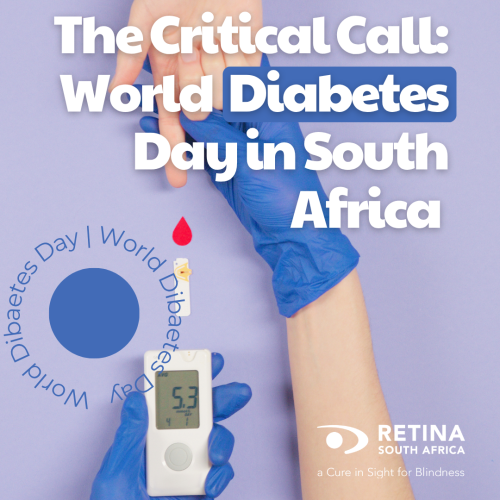The Critical Call: World Diabetes Day in South Africa
World Diabetes Day (WDD), observed annually on November 14th, is far more than just a date on the calendar in South Africa—it is a critical moment for health intervention.
The Scale of the Crisis
South Africa is grappling with an escalating diabetes crisis. With an estimated 4.2 to 4.6 million adults living with diabetes, the country has one of the highest prevalence rates in sub-Saharan Africa. Alarmingly, as many as 45% of these individuals are undiagnosed, essentially living with a ticking clock of potential complications. (https://pmc.ncbi.nlm.nih.gov/articles/PMC10218408/)
The statistics are sobering:
- Diabetes is a major cause of death, with some reports surpassing tuberculosis as the leading cause of death in the nation.
- It is a leading cause of vision loss
- in addition, poorly managed diabetes leads to severe complications like heart disease, stroke, kidney failure, and lower-limb amputation, placing a colossal strain on an already overburdened public healthcare system.
Why WDD Matters
WDD serves as a powerful, concentrated push to address this “silent killer.” For South Africa, the day’s importance is three-fold:
- Mass Awareness
The event provides a platform to run widespread awareness campaigns, directly tackling the high rate of undiagnosed cases. Early detection is the cornerstone of successful management and complication prevention.
- Education is the Cornerstone:
A key theme of WDD is often “Access to Diabetes Education.” In South Africa, education is vital to empower people to manage their chronic condition daily. It helps combat myths, promote healthy lifestyle changes (critical given the rise of Type 2 diabetes due to urbanisation and diet), and ensure adherence to treatment.
- A Call for Equitable Access:
The day pressures policymakers and healthcare providers to strengthen primary care and ensure all citizens—regardless of socio-economic status—have equitable and affordable access to comprehensive diabetes care, including medicines, technology, and support.
Simply put, World Diabetes Day in the South African context is a wake-up call. It’s a reminder that tackling this epidemic requires collective action, robust education, and a commitment to ensuring every person in the country can live a healthier, complication-free life with or without diabetes. It’s about turning awareness into action.
The Warning Signs: Common Symptoms of Diabetes
The symptoms of diabetes, especially Type 2, can be so mild that people often ignore them for years. That’s a mistake, as the long-term damage is happening silently. In fact, diabetes can even cause eye damage before the raised blood sugar leads to a diagnosis.
Look out for an expanding waist line, excess thirst, excess hunger, and excess urination. It is best to check with a health care professional if you are at risk.
The Risk Factors: Who is Most Vulnerable?
Risk factors can be broken down into two groups: those you can’t change and, more importantly, those you can change.
Factors You Cannot Change
- Age: Risk increases as you get older, especially after the age of 35.
- Family History: Having a parent or sibling with diabetes significantly increases your risk. Genetics play a big role.
- Race and Ethnicity: Certain populations, including people of African and Indian/Asian descent (both significant groups in South Africa), are at a higher genetic risk.
- History of Gestational Diabetes: Women who had diabetes during pregnancy are at increased risk later in life.
Factors that You CAN Change (The Modifiable Ones)
These are the most relevant factors for prevention:
- Excess Body Weight/Obesity: This is the single largest risk factor. Carrying extra weight, particularly around the abdomen, makes cells more resistant to insulin (insulin resistance).
- Physical Inactivity: The less active you are, the greater your risk. Exercise helps cells become more sensitive to insulin.
- Unhealthy Diet: A diet high in processed foods, sugary drinks, and saturated fat dramatically increases risk.
- High Blood Pressure (Hypertension): High blood pressure is often linked to diabetes and complicates its management.
- Smoking: Tobacco use increases insulin resistance.
The Good News: Prevention is Possible
For Type 2 diabetes, prevention is generally a matter of small, consistent lifestyle changes.
Move More: Aim for at least 150 minutes of moderate-intensity exercise (like brisk walking) per week.
Eat Better: Focus on colourful, whole, high-fibre foods (like vegetables and wholegrains) and drink water instead of sweetened beverages.

More Articles
Article title: Dis-Chem Ride for Sight – Why should you enter!!! – Newsflash No 2 .
Dis-Chem Ride for Sight 2022 Why should you enter? Great value for money- free gift of an event branded.
Article title: Ride for Sight Training Plan – 21 January 2025 .
Tuesday, January 21, 2025, 50-Minute Training Session This 50-minute session is designed to boost your cycling performance and endurance..
Article title: International Day for Persons with Disabilities .
The International Day of Persons with Disabilities, celebrated annually on December 3, was established by the United Nations General.